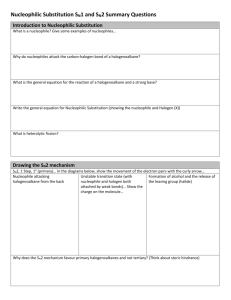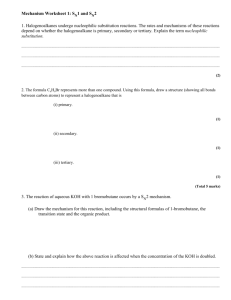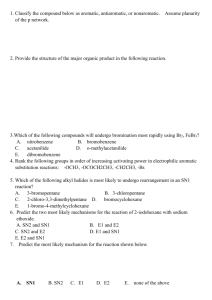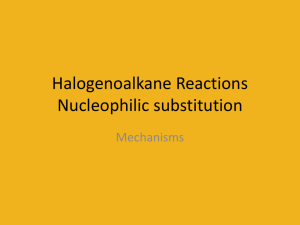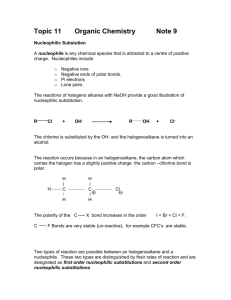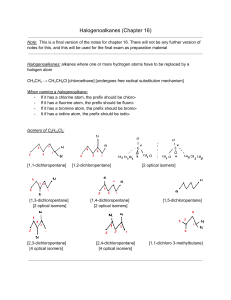Halogenoalkanes
advertisement
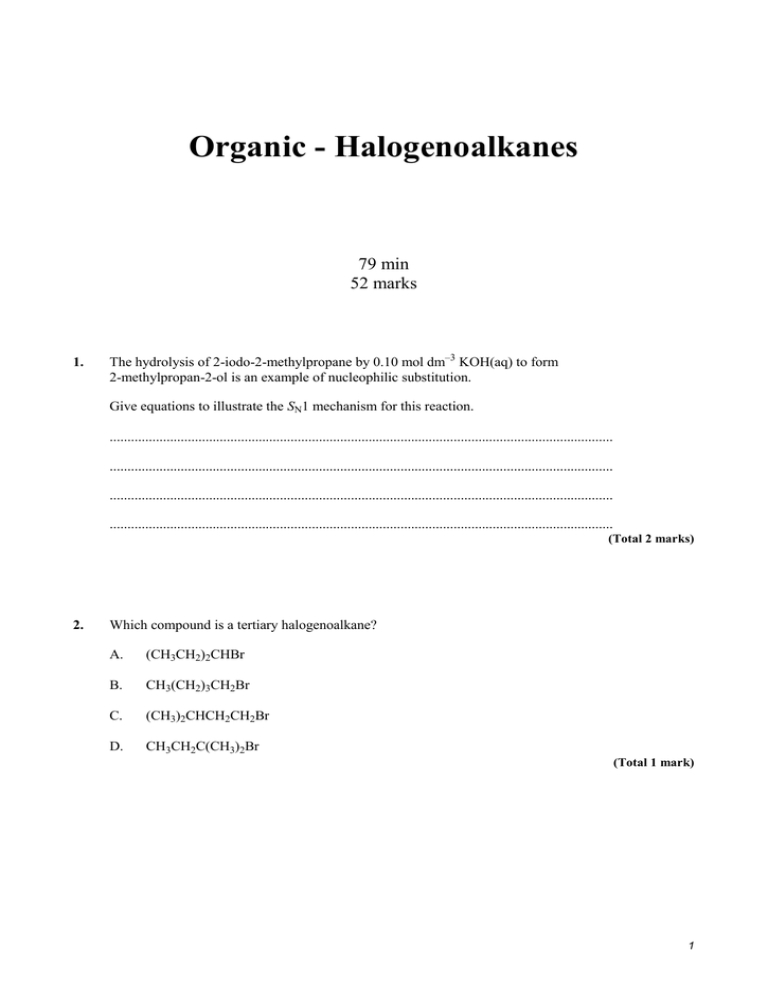
Organic - Halogenoalkanes 79 min 52 marks 1. The hydrolysis of 2-iodo-2-methylpropane by 0.10 mol dm–3 KOH(aq) to form 2-methylpropan-2-ol is an example of nucleophilic substitution. Give equations to illustrate the SN1 mechanism for this reaction. .............................................................................................................................................. .............................................................................................................................................. .............................................................................................................................................. .............................................................................................................................................. (Total 2 marks) 2. Which compound is a tertiary halogenoalkane? A. (CH3CH2)2CHBr B. CH3(CH2)3CH2Br C. (CH3)2CHCH2CH2Br D. CH3CH2C(CH3)2Br (Total 1 mark) 1 3. 2-bromobutane can be converted into butan-2-ol by a nucleophilic substitution reaction. This reaction occurs by two different mechanisms. (i) Give the structure of the transition state formed in the SN2 mechanism. (2) (ii) Write equations for the SN1 mechanism. (2) (Total 4 marks) 4. What is the reaction type when (CH3)3CBr reacts with aqueous sodium hydroxide to form (CH3)3COH and NaBr? A. Addition B. Elimination C. SN1 D. SN2 (Total 1 mark) 2 5. Write equations to show the mechanisms of the following reactions. In each case, show the structure of the intermediate and organic product, and use curly arrows to show the movement of electron pairs. (i) the reaction between KOH and CH3CH2CH2CH2Cl. (3) (ii) the reaction between KOH and (CH3)3CCl. (2) (Total 5 marks) 6. The molecular formula C4H9Br represents four structural isomers, all of which can undergo nucleophilic substitution reactions with aqueous sodium hydroxide. An equation to represent all these reactions is C4H9Br + NaOH C4H9OH + NaBr (a) Explain what is meant by the term nucleophilic substitution. (2) (b) The main mechanism for a tertiary halogenoalkane is SN1. Give the equations for this substitution reaction of the tertiary isomer of C4H9Br. Show the structures of the organic reactant and product and use curly arrows to show the movement of electron pairs. (4) 3 (c) The main mechanism for a primary halogenoalkane is SN2. Give the mechanistic equation for this substitution reaction of the straight-chain primary isomer of C4H9Br, showing the structures of the organic reactant and product, and using curly arrows to show the movement of electron pairs. (4) (d) Give a structural formula for the secondary isomer and for the other primary isomer. State the name of each isomer. (4) (Total 14 marks) 7. Which reaction type is typical for halogenoalkanes? A. nucleophilic substitution B. electrophilic substitution C. electrophilic addition D. nucleophilic addition (Total 1 mark) 8. (a) Halogenoalkanes undergo nucleophilic substitution reactions. The rates and mechanisms of these reactions depend on whether the halogenoalkane is primary, secondary or tertiary. Explain the term nucleophilic substitution. ...................................................................................................................................... ...................................................................................................................................... ...................................................................................................................................... ...................................................................................................................................... (2) 4 (b) The formula C4H9Br represents more than one compound. Using this formula, draw a structure (showing all bonds between carbon atoms) to represent a halogenoalkane that is (i) primary. (1) (ii) secondary. (1) (iii) tertiary. (1) (Total 5 marks) 9. Which formula is that of a secondary halogenoalkane? A. CH3CH2CH2CH2Br B. CH3CHBrCH2CH3 C. (CH3)2CHCH2Br D. (CH3)3CBr (Total 1 mark) 5 10. (a) The reaction of warm aqueous KOH with 1-bromobutane occurs by an SN2 mechanism. Draw the mechanism for this reaction, including the structural formulas of 1-bromobutane, the transition state and the organic product. (4) (b) State and explain how the rate of the above reaction is affected when the concentration of the KOH is doubled. ..................................................................................................................................... ..................................................................................................................................... ..................................................................................................................................... ..................................................................................................................................... (2) (c) State and explain how the rate of reaction of 1-chlorobutane in the above SN2 reaction compares with that of 1-bromobutane. ..................................................................................................................................... ..................................................................................................................................... ..................................................................................................................................... ..................................................................................................................................... (2) (Total 8 marks) 6 11. Which compound reacts most rapidly by a SN1 mechanism? A. (CH3)3CCl B. CH3CH2CH2CH2Br C. (CH3)3CBr D. CH3CH2CH2CH2Cl (Total 1 mark) 12. Which statement about the reactions of halogenoalkanes with aqueous sodium hydroxide is correct? A. Primary halogenoalkanes react mainly by an SN1 mechanism. B. Chloroalkanes react faster than iodoalkanes. C. Tertiary halogenoalkanes react faster than primary halogenoalkanes. D. The rate of an SN1 reaction depends on the concentration of aqueous sodium hydroxide. (Total 1 mark) 13. Bromoethane reacts with ammonia as follows. CH3CH2Br + NH3 → CH3CH2NH3+ + Br– CH3CH2NH3+ + NH3 → CH3CH2NH2 + NH4+ The mechanism for this reaction is described as SN2. (a) State the meaning of each of the symbols in SN2. ..................................................................................................................................... ..................................................................................................................................... ..................................................................................................................................... ..................................................................................................................................... (2) (b) State the name of the organic product of the reaction, CH3CH2NH2. ..................................................................................................................................... 7 (1) (c) Explain, using “curly arrows” to show the movement of electron pairs, the mechanism of the attack by ammonia on bromoethane, and show the structure of the transition state. (4) (Total 7 marks) 14. Which reaction(s) involve(s) the formation of a positive ion? I. CH3CH2CH2Br + OH– II. (CH3)3CBr + OH– A. I only B. II only C. Both I and II D. Neither I nor II (Total 1 mark) 8
